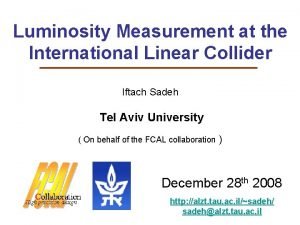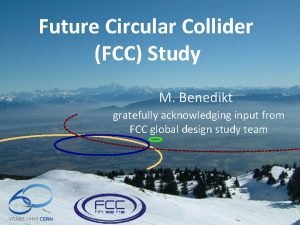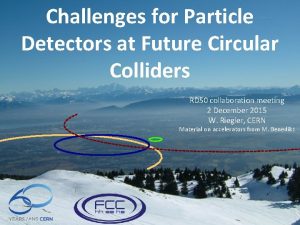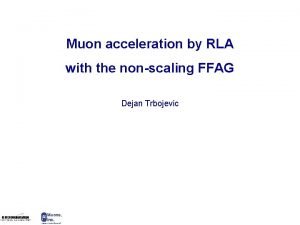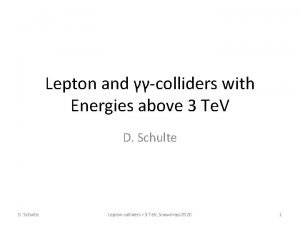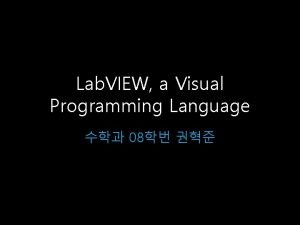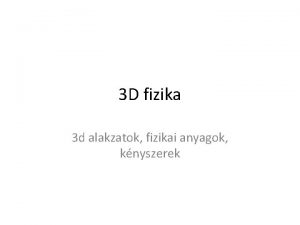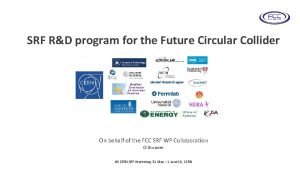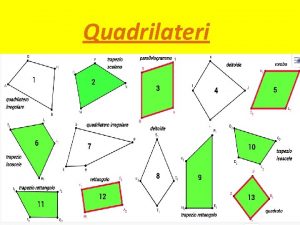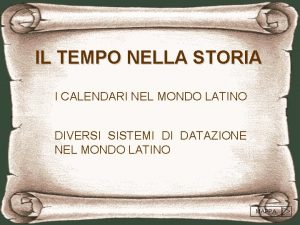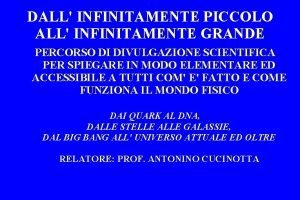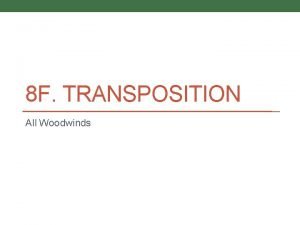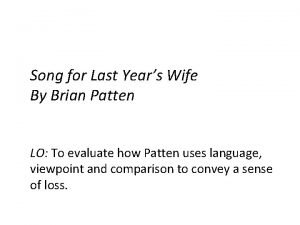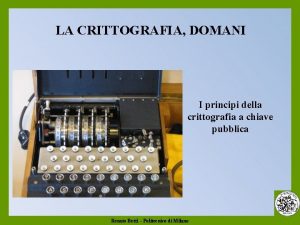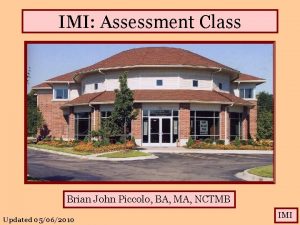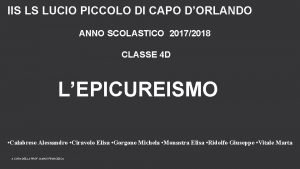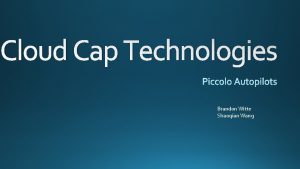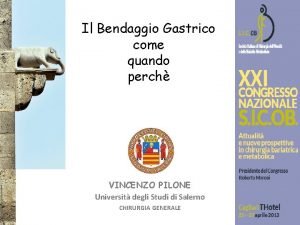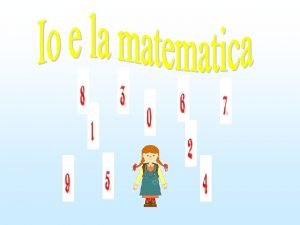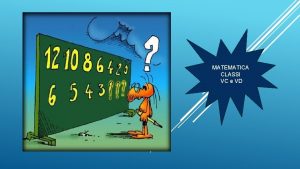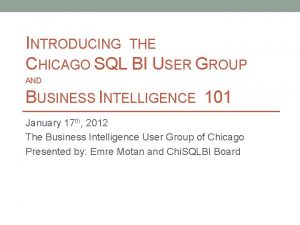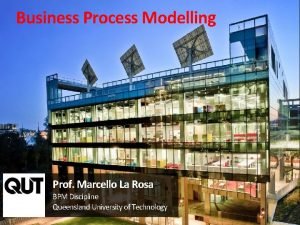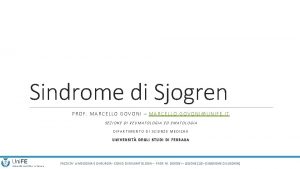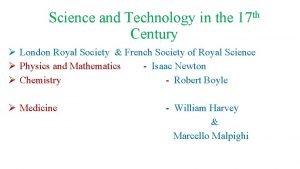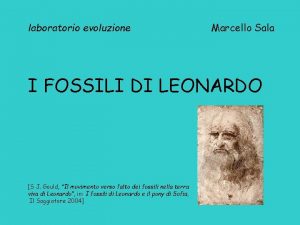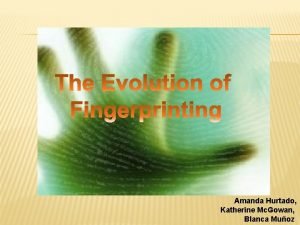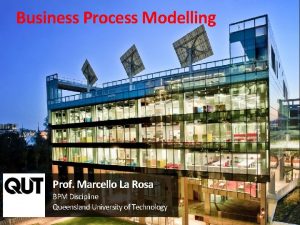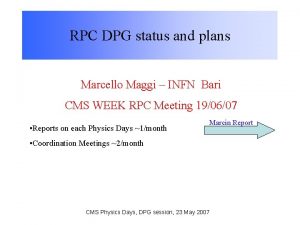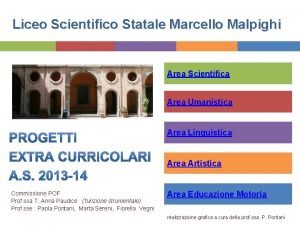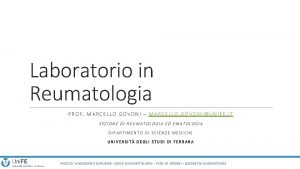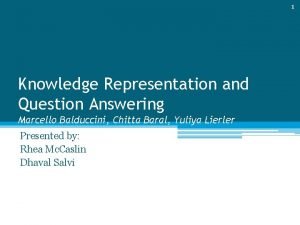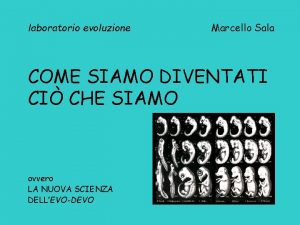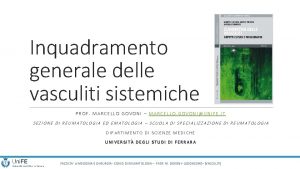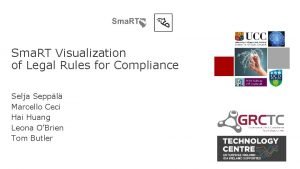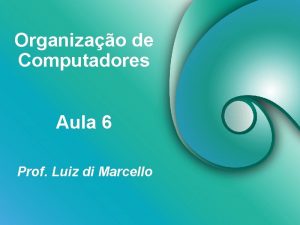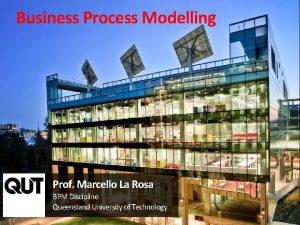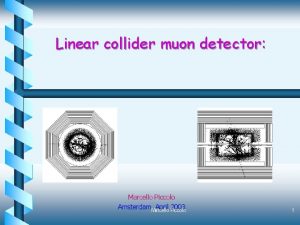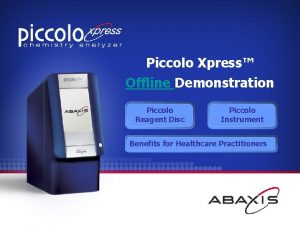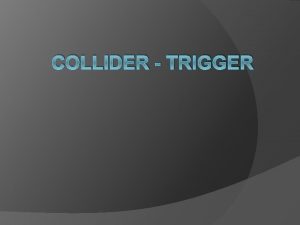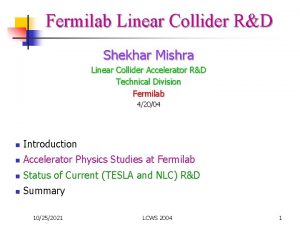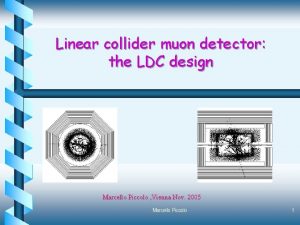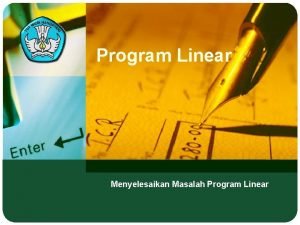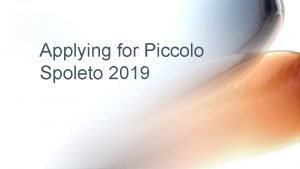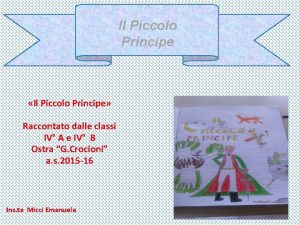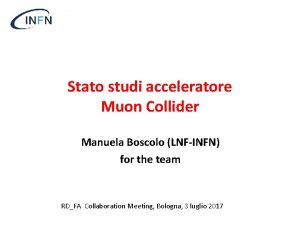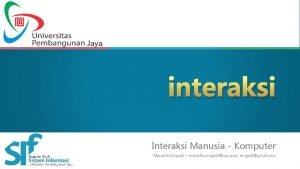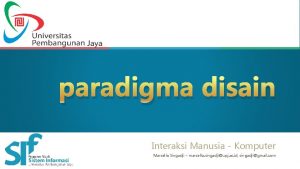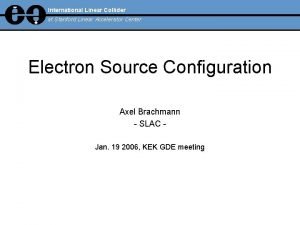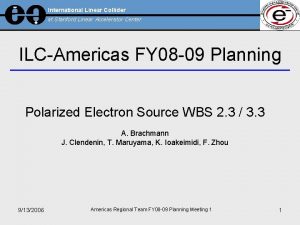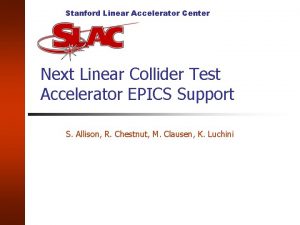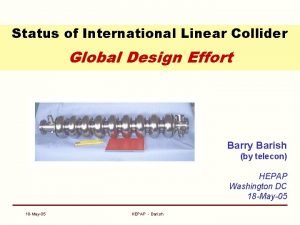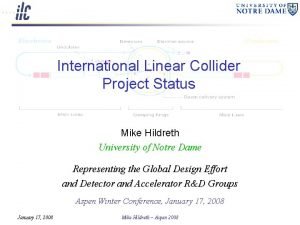The International Linear Collider program Marcello Piccolo LNFINFN




























































- Slides: 60

The International Linear Collider program. Marcello Piccolo LNF-INFN Frontier. Science, Milano Sept. 2005

Agenda • Brief historical excursus • The Physics case • The experimental challenges • Detector design (s) • Time scale • Conclusions M. Piccolo, Frontierscience, Milano 2005 Sept.

The start of the O(1 Te. V) L. C. • It is difficult to set a start date for a program that was in the back of at least 50% of particle physicists mind since at least 25 years. • I will arbitrarily set the start date at the Saariselka ( Finland ) meeting in September 1991. • It might be interesting to remember which kind of environment we were living in. M. Piccolo, Frontierscience, Milano 2005 Sept.

The lepton collider Physics at the end of 1991 • Going back to the summer of 1991 − 106 Z collected at LEP − The Standard Model was capable of describing everything LEP would turn out. − E. W. fits were almost perfect − The four LEP detectors were just turning toward heavy quark Physics. − For the record E. W. fits were giving : Mtop=120 ± 40 Ge. V/c 2 − CDF had an upper limit on top mass at 91 Ge. V/c 2 M. Piccolo, Frontierscience, Milano 2005 Sept.

The men with vision • Maury Tigner − The first one to think of it. • Nuovo Cimento 37 (1965) 1228 • Burt Richter − The first one to do it • SPC SLC • (Late) Bijorn Wiik − The superconducting RF advocate • TESLA ILC • His legacy is embedded the actual program M. Piccolo, Frontierscience, Milano 2005 Sept.

The study groups • Originally Europe, Japan and USA organized their own study groups. • After a while it was realized that a common framework was needed, and the LCWS was organized, with the aim of bringing together the regional groups to share experiences, results and …frustrations • This in my opinion was the starting of the global character of the effort. • Now here we are with a programs that carries the word International as a first name. M. Piccolo, Frontierscience, Milano 2005 Sept.

The Physics program : seeking answers the Te. V Scale The Te. V energy region hold the promise of giving back answers to our quests. Origin of mass and electro-weak symmetry breaking Why such a disparity between mweak and m. Planck What is most of the matter in the Universe made of and more… The Tevatron is already at work to open a window into this regime. LHC will allow a (quasi) complete view on phenomena at the Te. V scale! M. Piccolo, Frontierscience, Milano 2005 Sept.

Will the LHC be enough ? • Although the LHC is the most powerful research instrument ever built in our field, it does have limitations: • LHC detectors record about 10 -5 of the total cross section • Analysis will be carried out on 10 -10 of the total cross section. • No events balance visible longitudinal momentum. • Events with missing neutrals have unknown pt • High-purity b tagging, any charm tagging and t tagging is difficult • Most LHC analyses rely on a model. • They are powerful if the underlying assumptions are correct, not so powerful if wrong. M. Piccolo, Frontierscience, Milano 2005 Sept.

ILC Physics Case (TESLA TDR, Snowmass 01, ACFA report, …) Whatever LHC will find, one CANNOT give up the ILC, that warrants a Physics program which stands on his own feet. 1. If there is a ‘light’ Higgs (consistent with precision EW) proof that it is a particle responsible for giving masses (a) 2. If there is a ‘heavy’ Higgs (inconsistent with precision EW) verify the Higgs mechanism is at work as in (a) understand (in)consistencies with S. M. 3. 1. /2. & new states (SUSY, XD, little H, Z’, …) A completely spectroscopy is available to be discovered and measured 4. No Higgs, no new states (inconsistent with precision EW) find out what is wrong with the S. M. look for threshold effects of strong EWSB M. Piccolo, Frontierscience, Milano 2005 Sept.

ILC physics case Produce new particles look at deviations Find new type of states and measure it (cross sections, masses, Look at known processes and find deviations from the expected, through virtual effects. BR’s, Quantum numbers) Needs good experimental work AND good knowledge of what to expect. Peek deep into multi-Te. V region M. Piccolo, Frontierscience, Milano 2005 Sept.

Hadrons cry to loud (B. Toushek ca. 1960) e+ e- p p Electron positron collisions at high energy allow an almost complete exploration of the phenomena deemed relevant to EWSB. The initial state is made of individual constituents, and this provide some advantages with respect to protons. • very well defined (and tunable) centre-of-mass energy • …. and all of it usable. • clean, fully reconstructable events (no unknown pl ) • polarized beams. • moderate backgrounds • Unfortunately chronical lack of counting rate. M. Piccolo, Frontierscience, Milano 2005 Sept.

The ILC «ILC baseline parameters currently being discussed • Center-of-Mass Energy ~ 90 – 1000 Ge. V • Baseline Luminosity : 2 x 1034 cm-2 s-1 (>1000 x. LEP) Time Structure : 5 (10? ) Bunch-trains/s s Time between collisions: ~ 300 (150) ns e. g. TESLA TDR • `Backgrounds‘ (depends on ILC parameters) e+e-gqq ~100/hr e+e-g. W+W- ~1000/hr e+e-gtt ~50/hr e+e-g. HX ~10/hr e+e-gqq ~0. 1 /Bunch Train + e e gggg. X ~200 /Bunch Train ~500 hits/BX in Vertex det. ~5 tracks/BX in TPC « Event rates modest – small compared to LHC M. Piccolo, Frontierscience, Milano 2005 Sept.

Configuration Parameter Space M. Piccolo, Frontierscience, Milano 2005 Sept.

Impact on Detector Design « « Radiation hardness not a big concern. Time structure of the machine not demanding. Worst type of Physics background gg. Angle crossing to be studied in detail. « Final focus lenses (L* ) have big effect on backgrounds The detector design dictated by Physics MDI + crossing-angle important : might place constraint on design M. Piccolo, Frontierscience, Milano 2005 Sept.

Physics processes • To asses the capabilities of the ILC, I will go over few individual reactions: − − Higgs Physics Super symmetry studies Gauge bosons Top M. Piccolo, Frontierscience, Milano 2005 Sept.

Higgs Physics • If can use Higgstrahlung, model independent observation. • mass measurements • absolute branching ratios Garcia-Abia et al • total width • spin, CP • top Yukawa coupling • self coupling M. Piccolo, Frontierscience, Milano 2005 Sept.

Higgs at LHC • LHC will discover some Higgs, if it is there within three years (2011? ) • Will a discovery be enough ? I doubt it. • Let us suppose to discover H gg , and to see, as a cross check a final state tt. H. • Technipion? Scalar or pseudo-scalar? Does it couple with W/Z? M. Piccolo, Frontierscience, Milano 2005 Sept.

Legitimate questions • Was the Higgs boson discovered ? − Is it the particle responsible for mass ? − Does it have the correct spin parity assignment 0+? − Is it really the condensate that fills the Universe ? • To prove that it is indeed what gives mass to particles − Spin/Parity − Couplings − Vacuum expectation value − Branching Ratios − Self coupling M. Piccolo, Frontierscience, Milano 2005 Sept.

Higgs Boson at LC • Angular distributions in e+e– ZX depend on X=h, A, V M. Piccolo, Frontierscience, Milano 2005 is it a 0+? Sept.

Higgs Boson at LC • Branching Fractions prove couplings mass. The Higgs is responsible for masses. (Battaglia) M. Piccolo, Frontierscience, Milano 2005 Sept.

Higgs Boson at LC • Final state ZH • ALR is proof that is produced by s-channel Zexchange • If Z gauge boson, H scalar boson only two vertices possible • A VEV is needed to have a ZZH vertex. • Measurement of g. Z will prove that Z mass is (partly) due to the scalar. H. Murayama LBL-38891 M. Piccolo, Frontierscience, Milano 2005 Sept.

Precision Higgs physics SM 2 HDM/MSSM Yamashita et al M. Piccolo, Frontierscience, Milano 2005 Sept. Zivkovic et al

Now, we have the Higgs and we know is the one that generates masses…… • The S. M. assumes a negative . Why ? • Yes, there is a condensate that shields the weak force. • Why do we have something that condenses ? Why the condensation scale ~Te. V<<MPl M. Piccolo, Frontierscience, Milano 2005 Sept.

Possible (model) solutions • Super symmetry − Crisis with the electron self energy: …. introduction of antimatter − Double # particles + boson to fermion and viceversa • Cooper pair mechanism − Cooper pairs: two electrons bond together − Higgs as a fermion antifermion pair Technicolor • Physics ends @ Te. V scale − Ultimate scale: quantum gravity − Gravitational effects @ ~Te. V hidden dimensions M. Piccolo, Frontierscience, Milano 2005 Sept.

Supersymmetry If it is there LHC will discover super symmetry; however many hard questions will be still unanswered or partially answered: • is it really SUSY? (measurement of quantum numbers) • how is it realized? (MSSM, NMSSM, …) • how is it broken? ILC will be able to provide answers to these questions! Make full use of the flexibility of the machine: - tunable energy - polarized beams - possibly e-e- and collisions 200 500 1000 3000 Sobloher M. Piccolo, Frontierscience, Milano 2005 Sept.

Super symmetry at LC • To prove : effective superpartners − Spins differ by 1/2 − Same quantum numbers SU(3) SU(2) U(1) − Super symmetric couplings M. Piccolo, Frontierscience, Milano 2005 Spin 0? Sept.

Supersymmetry at LC (cont. ) Two methods to obtain absolute sparticle masses: in the continuum: at the kinematic threshold: Martyn many more observables than just masses: - angular distributions, FB-asymmetries - cross sections - LR-asymmetries - ratios of branching ratios Freitas possibility to determine SUSY parameters without many model assumptions M. Piccolo, Frontierscience, Milano 2005 Sept.

Supersymmetry LC + LHC A LHC/LC joint effort: errors of a 19 -parameter fit using ILC+LHC: The overall results on SS data fitting: It is clear that neither of the two programs would have such an analyzing Power. Bechtle et al allows for model-independent investigation of GUT/Planck scale features of theory: Porod et al M. Piccolo, Frontierscience, Milano 2005 Sept.

The Cosmic Connection SUSY provides excellent candidate for dark matter (LSP) (Other models provide Te. V-scale WIMPs too) Sensitivity for DM search at accelerators of the same order as astrophysics searches…. ALCPG study/prel. DM/ DM bulk 3. 5% focus 1. 9% main sensitivity co-ann. 6. 5% funnel 3. 1% M. Piccolo, Frontierscience, Milano 2005 Sept.

And if no Higgs comes around ? Cross section for weak vector boson scattering violates unitarity at ~1. 2 Te. V, and no new resonances appear ILC sensitivity deep into multi-Te. V region from VB final states eff. Lagrangian parameters of strong EWSB: Higgsless model: new resonance in WZ WZ Coupling structure from ILC if resonance seen by LHC Krstonosic et al. M. Piccolo, Frontierscience, Milano 2005 Sept. Birkedal et al.

Top We know that is there. Threshold scan provides remarkable improvement on mass measurement Theory (NNLL) controls mt(MS) to 100 Me. V Hoang et al very precise mtop vital - improved SM fits - MSSM (mh prediction) - DM-density in m. Sugra -… M. Piccolo, Frontierscience, Milano 2005 Sept. Heinemeyer et al

Detector Design for the ILC Optimize the detector so that every bit of luminosity counts In e+e- colliders we always fight with small cross sections. Limit systematic errors Requirements different from LHC detectors Overall detector concept R&D on key components M. Piccolo, Frontierscience, Milano 2005 Sept.

A detector with Particle flow To exploit to the fullest the ILC environment one seeks complete reconstruction of complex final states (multi-jets, tau’s) often accompanied by missing-E How can we achieve the very best energy resolution for jets ? Generally accepted paradigm: Particle flow is: - a detector concept - and an algorithm M. Piccolo, Frontierscience, Milano 2005 Sept.

The Particle Flow Algorithm Basic idea: reconstruct every single particle in the event for each particle type exploit the detector subsystem which can do that best! ~60% charged tracker ~30% photons (from 0) ECAL ~10% neut. hadrons HCAL sounds reasonable challenge: cluster mixing/double counting Separate charged from neutral: B field, R, trans. granularity, material EM from HAD: trans. + long. granularity (“shower tracking”) Goal : DE/E = 30%/E 0. 5 M. Piccolo, Frontierscience, Milano 2005 Sept.

The Particle Flow Algorithm (cont. ) Resolution terms relevant: hadronic energy and wrong clustering Build the best hadronic calorimeter Minimize wrong clustering Granularity M. Piccolo, Frontierscience, Milano 2005 Sept.

Detector concept studies 3 different incarnations of a PF detector studied They have a lot in common: - both ECAL+HCAL inside coil - highly-granular calorimeter - precision pixel vertex detector - common R&D on components! Si. D www-sid. slac. stanford. edu LDC concepts, but no closed ‘collaboration’ www. ilcldc. org They differ in: choice of tracking: TPC vs. Si magnetic field 3 – 5 T GLD ilcphys. kek. jp/gld/ inner radius of ECAL choice of ECAL readout Si vs Sc M. Piccolo, Frontierscience, Milano 2005 Sept.

A different detector concept • At the Snowmass meeting in August a new detector concept was presented: • The main difference with respect to the traditional PFA detectors is that the calorimeter system on which is based can, by construction, separate e. m. energy, e. m. + hadronic energy and may be the binding energy of nuclear components …. . M. Piccolo, Frontierscience, Milano 2005 Sept.

Dual-Readout Module (DREAM) “Unit cell” M. Piccolo, Frontierscience, Milano 2005 Sept.

Design Issues and Detector R&D Detector integral part of ILC Design – meet schedule of GDE Concept optimisation & R&D to be carried out …. since yesterday! Key components: 1. Vertex Detector R&D review Panel established by world-wide LC study to promote and coordinate detector R&D for the ILC 2. Charged Particle Tracking 3. Calorimetry 4. Muon system Keeps tabs of R&D activities around the world at: 5. Trigger 6. Forward Region 7. Machine Detector Interface https: //wiki. lepp. cornell. edu/wws/ M. Piccolo, Frontierscience, Milano 2005 Sept.

Vertex Detector ( the GLD preliminary optimization) heavy flavour tagging is a tool of choice « Important for many physics analyses e. g. couplings of a low mass Higgs Want to prove g. Hff~mf O(%) measurements of the branching ratios Hgbb, cc, gg do We like to be better than before sd 0 ~ a Å b/[p(Ge. V)bsin 3/2 q] Goal: a=5 mm, b=10 mm a: point resolution, b : multiple scattering M. Piccolo, Frontierscience, Milano 2005 Sept.

Main design considerations: «Inner radius: ~20 mm for impact parameter resolution the smaller the better «Layer Thickness: as thin as possible minimize conversions, reduce M. S. Constraints: T. Maruyama + « Inner radius constrained by e e pair depends on the f. f. details + B field « Layer thickness depends on Si technology In the end, design driven by machine + technology ! GLD Baseline design: B=5 T GLD Baseline «Fine pixel CCDs (FPCCDs) «Point resolution : 5 mm «Inner radius : 20 mm «Outer radius : 50 mm «Polar angle coverage : |cosq|<0. 9 BUT ultimate design depends on worldwide detector R&D M. Piccolo, Frontierscience, Milano 2005 Sept.

Backgrounds in GLD VTX « Assuming to be able to bear 0. 5% occupancy, set the radius of the first layer accordingly How much of a disadvantage is B = 3 T ? 5 T 3 T 4 T Sugimoto s GLD VTX Forced to a slightly larger inner radius : 2 mm ? s Will depend on ILC parameters/MDI ! s This is a disadvantage of lower B-field in GLD concept s How much does the larger inner radius matter ? M. Piccolo, Frontierscience, Milano 2005 Sept.

« Main impact – charm tagging, e. g. Tesla study Rinner = 26 mm T. Kuhl Rinner = 15 mm «Here charm-tagging efficiency for 70 % purity decreases from 45 % 30 % as Rinner increased from 15 mm 26 mm NOTE: not completely fair comparison as different wafer thickness « 3 Tesla field not helpful from point of view of charm-tagging « BUT probably not a big concern M. Piccolo, Frontierscience, Milano 2005 Sept.

Vertex Detector Many technologies under study – very active field CCD DEPFET MAPS and many others… CCD with column par. r/o DEPFET Mimosa 9 (MAPS) 750 x 400 pixels 20 m pitch CPR 1 1 MPixel M. Piccolo, Frontierscience, Milano 2005 Sept.

Central Tracking Driving Physics: Particle Flow: efficiency (kinks , high d. E/dx), resolution less important Higgs recoil mass, SUSY di-lepton endpoints: momentum resolution Two options: Gaseous or Silicon tracker? TPC: Si: >200 3 D space points with ‘gas type’ point-res O(100µm) (LDC, GLD) 5 (pix) + 5 (strips) high-res point-res o(few µm) (Si. D) M. Piccolo, Frontierscience, Milano 2005 Sept.

TPC R&D Use Micro Pattern Gas Detectors (GEMs, Micro. Megas) for gas amplification - native 2 D structure - ion-feedback suppression built in -- thin end-plates R&D topics: -stable operation on large scale - optimize resolution/pad geometry - operation in magnetic field - field cage design Significant effort worldwide LC-TPC collaboration M. Piccolo, Frontierscience, Milano 2005 Sept.

Central Tracking: Silicon Tracker Si. LC collaboration R&D: GOAL: testbeam in 2006 long ladders (Reduce M. S. ) long shaping time: low noise develop r/o chips pattern recognition use VTX as seed momentum resolution: simulation FE prototype ASIC M. Piccolo, Frontierscience, Milano 2005 Sept.

Calorimetry Driving physics: Jet energy resolution in multi-jet (6, 8, . . ) events tau reconstruction non-pointing photons E. G. : Strong EW symmetry breaking distinguish W and Z in their hadronic decays w/o kinematic constraints ALEPH like resolution ILC goal M. Piccolo, Frontierscience, Milano 2005 Sept.

The H self coupling M. Piccolo, Frontierscience, Milano 2005 Sept.

Calorimetry Calorimeter and Particle Flow algorithm are a real challenge Present technologies under study: EM calorimeter: Si W (Si. D, LDC), Sc W (GLD) HAD calorimeter: scintillating tiles (‘analog’) RPC, GEM, tiles (‘digital’) addressed by a world-wide R&D effort e. g. CALICE: 26 Institutes, 9 Countries in 3 Regions ECAL 1 st testbeam at DESY 2 electrons, ~3 cm apart Testbeam data! M. Piccolo, Frontierscience, Milano 2005 Sept.

HCAL Fluctuations of hadronic showers Simulation of same 6 Ge. V pion: HCAL issues: active medium gaseous or scintillator? Understand hadron showers Scintillator: new possibilities with small photo-sensors (“Si. PMs”) Prototype construction under way Scintillator plane with Si. PM r/o Minical prototype at DESY Detail of Si. PM M. Piccolo, Frontierscience, Milano 2005 Sept.

ECAL+HCAL joint testbeam 1 m 3 prototype testbeam planned for 2006 detailed understanding of el-mag and hadronic showers in a highly-granular Calorimeter Tail Catcher HCAL Electronic Racks ECAL Beam M. Piccolo, Frontierscience, Milano 2005 Sept.

Radiator choice for Had. Cal. • Lately W was looked at as a possible radiator for the Had-cal. • Detailed evaluation ongoing. • Material cost could be offset by smaller radius…. • S. C. Coil could cost much less. M. Piccolo, Frontierscience, Milano 2005 Sept.

Simulation of cal. overall performances • Simulation results with the two had. cal. options for the LGD M. Piccolo, Frontierscience, Milano 2005 Sept.

Trigger and DAQ • The common wisdom is that there is no need for triggering. • The idea, as of now, is to use commercial hardware to pipeline the data during the beam crossing (~ 1 msec. ) and build the event during the intra-beam time (~200 msec. ) • Individual detectors might tag “interesting bunch crossings” • Really a no-bias trigger. M. Piccolo, Frontierscience, Milano 2005 Sept.

Program development Aug. 2005 (Snowmass) - optimize detector parameters. Prepare inputs to machine. End 2005 - A detector R&D document to go with the machine baseline configuration document. End 2006 - Detector Concept Report (one document with multiple concepts, costed) to go with the machine reference design report. 2008 Detector Concept will be part of: ILC Technical Design report …let me now borrow GDE director transparencies from his Snowmass presentation: M. Piccolo, Frontierscience, Milano 2005 Sept.

Approach to ILC R&D Program • Proposal-driven R&D in support of the baseline design. − Technical developments, demonstration experiments, industrialization, etc. • Proposal-driven R&D in support of alternatives to the baseline − Proposals for potential improvements to the baseline, resources required, time scale, etc. • Develop a prioritized DETECTOR R&D program aimed at technical developments needed to reach combined design performance goals M. Piccolo, Frontierscience, Milano 2005 Sept.

GDE – Near Term Plan • Schedule • Begin define Configuration (Snowmass Aug 05) • Baseline Configuration Document by end of 2005 ----------------------------------- • Put Baseline under Configuration Control (Jan 06) • Develop Reference Design Report by end of 2006 • Three volumes -- 1) Reference Design Report; 2) Shorter glossy version for non-experts and policy makers ; 3) Detector Concept Report M. Piccolo, Frontierscience, Milano 2005 Sept.

The GDE Plan and Schedule 2005 2006 2007 2008 2009 2010 Global Design Effort Baseline configuration Reference Design Project LHC Physics Technical Design ILC R&D Program Bids to Host; Site Selection; International Mgmt

Conclusions • ILC Physics program is compelling; it does stand on its own. • LHC and ILC are two remarkable instruments that will help us make the big step forward in understanding our Universe. • In my opinion, there will be a big positive interference between the LHC and ILC programs. • Development of the detectors is considered an integral part of the GDE. • The schedule for the technical reports/designs is ambitious. 2008 is close: plenty of possibilities to come and contribute to the startup of this program. M. Piccolo, Frontierscience, Milano 2005 Sept.
 International linear collider
International linear collider Fcc collider
Fcc collider Fcc collider
Fcc collider Muon collider
Muon collider Muon collider
Muon collider Visual basic programming language
Visual basic programming language Unity sphere collider
Unity sphere collider Hadron collider
Hadron collider Hadron collider
Hadron collider Fcc-ee
Fcc-ee Angoli adiacenti al lato
Angoli adiacenti al lato Who invented the piccolo
Who invented the piccolo Calendari nel mondo
Calendari nel mondo Infinitamente grande e infinitamente piccolo
Infinitamente grande e infinitamente piccolo Piccolo transposition
Piccolo transposition Brian piccolo wife
Brian piccolo wife Piccolo teorema di fermat
Piccolo teorema di fermat Piccolo teorema di fermat
Piccolo teorema di fermat Kyphosis symptoms
Kyphosis symptoms Quadrifarmaco
Quadrifarmaco Piccolo teorema di fermat
Piccolo teorema di fermat Il caso del piccolo albert
Il caso del piccolo albert Brandon witte
Brandon witte Filastrocca del piccolo gesto importante
Filastrocca del piccolo gesto importante Vincenzo pilone chirurgo
Vincenzo pilone chirurgo Sin da piccola
Sin da piccola Svasso piccolo
Svasso piccolo Numeri decimali dal più piccolo al più grande
Numeri decimali dal più piccolo al più grande A mi me piace a nutella
A mi me piace a nutella Rondone codacuta
Rondone codacuta Il bambino non è un piccolo adulto
Il bambino non è un piccolo adulto Brian john piccolo
Brian john piccolo Uri il piccolo sumero
Uri il piccolo sumero Brian nagra
Brian nagra Struttura
Struttura Dinamica mentale laboratorio
Dinamica mentale laboratorio Marcello benati
Marcello benati Marcello la rosa
Marcello la rosa Professor marcello govoni
Professor marcello govoni Marcello malpighi contribution to fingerprints
Marcello malpighi contribution to fingerprints Marcello peres zanfra
Marcello peres zanfra Marcello sala
Marcello sala Johann christoph andreas mayer
Johann christoph andreas mayer Reumatologia
Reumatologia Marcello la rosa
Marcello la rosa Maggi plans
Maggi plans Marcello colledani
Marcello colledani Liceo scientifico marcello malpighi
Liceo scientifico marcello malpighi Marcello govoni curriculum
Marcello govoni curriculum Marcello balduccini
Marcello balduccini Marcello sala
Marcello sala Granulomatosi di wegener forum
Granulomatosi di wegener forum Marcello ceci
Marcello ceci Luiz di marcello
Luiz di marcello Marcello sala
Marcello sala Marcello la rosa
Marcello la rosa Gan optimist
Gan optimist Hát kết hợp bộ gõ cơ thể
Hát kết hợp bộ gõ cơ thể Slidetodoc
Slidetodoc Bổ thể
Bổ thể Tỉ lệ cơ thể trẻ em
Tỉ lệ cơ thể trẻ em
